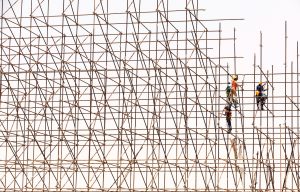 With the Coronavirus ravaging societies across the globe, what is its potential impact on the scaffolding industry?
With the Coronavirus ravaging societies across the globe, what is its potential impact on the scaffolding industry?
Reports currently indicate that there are over 100,000 confirmed cases of COVID-19 globally and, as Scaffmag was going to press, there were already 90 cases in the UK.
On Tuesday, the government, which is determined to slow down the spread of this highly infectious disease, outlined some rather drastic measures should the situation get any worse. These planned measures include the ban of large public gatherings, shutting down schools, cancelling events, and working from home. However, this isn’t possible in the scaffolding and wider construction sector.
Reports indicate that it is highly likely that nearly 80% of workers could be forced to stay out of work during the upcoming peak weeks of the outbreak.
It has been established that the pandemic is already affecting the sector after the energy firm EDF, which is constructing two new nuclear reactors yesterday announced that one of its workers on Hinkley Point C had been infected with the virus.
Supply of Materials
While scaffold and shrink wrap hire can be sourced in the UK, most scaffolding materials such as tube and fittings are usually imported from China, which is the epicentre of the Coronavirus, the supply chains are also bound to be affected.
The company, in a statement released to Scaffmag, stated that because of the nature of its business and as pre-planned, it had utilised its total production capacity during the months of winter up to February. Additionally, it had also gone on expanding the stocks at its Germany factory and its more than 140 service centres around the globe.
Layher stated that they do this to be well prepared for the traditionally busy summer and spring seasons. Thanks to uncertainties in the past over Brexit, Layher UK had already significantly increased its high stock levels.
Layher also confirmed that they have a similarly large stock of raw materials, and they don’t have to rely on supplier products, for example, from China. They will be good for many months.
Scaffolding Training
Scaffolding training courses all over the UK and worldwide were completely halted once the lockdown was announced. This means that a lot of scaffolders have been unable to engage in the crucial training required to uphold high standards of scaffolding safety. Since there hasn’t been any delivery of Scaffolder CPD courses, a lot of Scaffolders are anxious as they await the chance to refresh their CISR cards.
Training is done for established professionals and newcomers alike; it is continuously adapting to changes in legislation and the best practice techniques. Due to training being halted, experts are looking to find new ways to make sure that those in the industry go on with their learning.
Procedures at Construction Sites
Ever since the COVID-19 pandemic started, the government has been determined to keep construction work going, albeit with various restrictions. The industry is now faced with the challenge of ensuring that workers remain safe against construction sites’ typical risks. They have to do this while also ensuring that they maintain proper social distancing to avoid the spread of the virus. Most of the instructions provided are generic, and due to this, SIMIAN is hard at work trying to determine how they may be applied in scaffolding. We have provided our clients with our internal ‘Guidance for Scaffolders.’ We will soon be revising that to include the most recent revisions to industry guidance, such as the Site Operating Procedures formulated by the Construction Leadership Council.
Here are the various ways in which our clients are adhering to social distancing rules:
- On-site hand sanitizers;
- Travelling alone;
- Restricting the number of workers operating lifts and hoists;
- Creating additional space in washrooms and break out facilities;
- Staggering break times and shifts;
- One-way systems;
- Work gang consistency;
- Cleaning frequent touchpoints and equipment (for example handles and buttons).